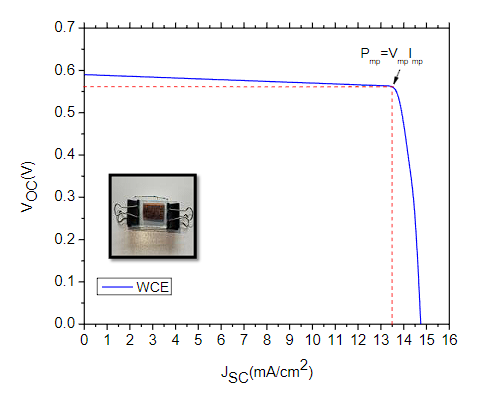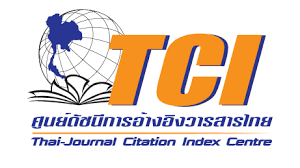Effect of Counter Electrode from Waste Carbon in Factory for Dye-Sensitized Solar Cell
doi: 10.14456/mijet.2023.14
Keywords:
dye-sensitized solar cell (DSSC), waste carbon in factory, counter electrodeAbstract
The incomplete combustion of coal fuels produces smoke that is emitted outside, which uses a wet scrubber process to reduce smoke. The waste produced by this process is carbon. This waste carbon can be used as a film material on the counter electrode layer of a dye-sensitized solar cell (DSSC). The effect of a counter electrode made from waste carbon in factory for dye-sensitized solar cell (WCFCE-DSSC) is presented in this study. For the counter electrode, transparent conductive oxide (TCO) glass was coated with the waste carbon in factory. X-ray diffraction (XRD) was confirmed by crystalline structure of the waste carbon in the factory, which shows peak intensity at the carbon (002) plane and 27.33° (2q). At AM 1.5 and 600 W/m2, the result was that the open-circuit voltage (VOC) and the short-circuit current density (JSC) of the WCFCE-DSC were 0.59 V and 14.7 mA/cm2, the filter factor (FF) and the energy conversion efficiency (h) were 0.87 and 1.27%, respectively. The VOC was lower than all material counter electrodes when compared to the research group using counter electrodes. The energy conversion efficiency is lower because waste carbon in factory may contain impurities that reduce the redox reaction and decrease electron atoms.
References
R. Chilipi, N. Al Sayari and J. Y. Alsawalhi, "Control of Single-Phase Solar Power Generation System With Universal Active Power Filter Capabilities Using Least Mean Mixed-Norm (LMMN)-Based Adaptive Filtering Method," IEEE Transactions on Sustainable Energy, vol. 11, no. 2, pp. 879-893, 2020.
J. Feng, J. Yang, H. Wang, H. Ji, M, O. Okoye, J. Cui, W. Ge, B. Hu and G. Wang, “Optimal dispatch of high penetration of renewable energy power planning considering coordination of source-load-storage multi-type flexible resource,” Energies, vol. 13, no. 13, pp. 27-34, 2020.
T. Da, C. Hou, R. Li, D. Zhang and J. Li, “Equilibrium Analysis on Deep Peak Regulation Market Considering the Participation of Virtual Power Plants,” Proc. of 6th Int. Conf. Power. Renew. Ener, ICPRE2021, Shanghai, China, September 17-20, 2021, pp. 1068-1072.
X. Lang, T. Yang, Z. Huang, Z. Wang, S. Bozhko and P. Wheeler, "Instantaneous Power Control Within an Advanced Power Generation Center for More-Electric Aircraft Applications," IEEE Transactions on Transportation Electrification, vol. 8, no. 3, pp. 3261-3274, 2022.
S. O. Abdellatif, S. Josten, A. S. G. Khalil, D. Erni and F. Marlow, "Transparency and Diffused Light Efficiency of Dye-Sensitized Solar Cells: Tuning and a New Figure of Merit," IEEE Journal of Photovoltaics, vol. 10, no. 2, pp. 522-530, 2020.
D. Sengupta and K. Mukherjee, "Performance Analysis of Several ZnO-Based Dye-Sensitized Solar Cells With Identical Photoelectrodes, Electrolyte, and Sensitizer," IEEE Journal of Photovoltaics, vol. 11, no. 4, pp. 991-996, 2021.
M. M. Hassan, Z. S. Ismail, E. M. Hashem, R. Ghannam and S. O. Abdellatif, "Investigating the Tradeoff Between Transparency and Efficiency in Semitransparent Bifacial Mesosuperstructured Solar Cells for Millimeter-Scale Applications," IEEE Journal of Photovoltaics, vol. 11, no. 5, pp. 1222-1235, 2021.
Z. Bouzid and Y. Halimi, "Performance Enhancement of Eucalyptus Extract Based Dye Sensitized Solar Cell Using TiO2/Embedded Capsaicin Photoanode," IEEE Sensors Journal, vol. 22, no. 13, pp. 12761-12768, 2022.
Y. -H. Nien et al., "Improving Photovoltaic Performance of Dye-Sensitized Solar Cell by Modification of Photoanode With g-C3N4/TiO2 Nanofibers," in IEEE Transactions on Electron Devices, vol. 68, no. 10, pp. 4982-4988, 2021.
S. Sharma and V. Singh, "Carbon Nanotubes in Emerging Photovoltaics: Progress and Limitations," IEEE Journal of Photovoltaics, vol. 12, no. 1, pp. 167-178, 2022.
L. K. Peng and T. -C. Wu, "Different Concentrations of Carbon Nanotubes/Graphene and TiO2 Composite Photoanodes for Dye-sensitized Solar Cells," 2021 IEEE 3rd Eurasia Conference on IOT, Communication and Engineering (ECICE), Yunlin, Taiwan, 29-31 October 2021, pp. 510-513, 2021.
H. J. Kim, B. Han, C. G. Woo and Y. J. Kim, "NOx Removal Performance of a Wet Reduction Scrubber Combined With Oxidation by an Indirect DBD Plasma for Semiconductor Manufacturing Industries," IEEE Transactions on Industry Applications, vol. 54, no. 6, pp. 6401-6407, 2018.
J. H. Sung, S. Kim, S. Kim, B. Han, Y. J. Kim and H. J. Kim, "Development of an Integrated Electrostatic Precipitator and Wet Scrubber System for Controlling Nox and Particulate Matter Emissions From a Semiconductor Manufacturing Process, "IEEE Transactions on Industry Applications, vol. 56, no. 6, pp. 7012-7019, 2020.
R. A. Toor and M. H. Sayyad, "Candle soot based carbon counter electrode for cost-effective dye sensitized solar cells," in 2021 International Bhurban Conference on Applied Sciences and Technologies (IBCAST), Islamabad, Pakistan, pp. 87-92, 2021.
H. T. Chou, C. H. Lien, D. H. Wu, H. -C. Hsu and M. -H. Huang, "The different film thicknesses of graphite/carbon black on the counter electrodes by spray coating method for dye-sensitized solar cells," 2013 13th IEEE International Conference on Nanotechnology (IEEE-NANO 2013), Beijing, China, 5-8 August 2013.
S. C. Ramesh, P. Ramkumar, C. C. Columbus and X. S. Shajan, "Experimental and Simulation Studies of Platinum-Free Counter Electrode Material for Titania Aerogel-Based Quasi-Solid Dye-Sensitized Solar Cell," in IEEE Journal of Photovoltaics, vol. 10, no. 6, pp. 1757-1761, 2020.
S. Intharatholo, S. Panmung, P. Chansri and T. Tomrongkunanan, "A Waste Carbon Copy Paper Counter Electrode For Dye-Sensitized Solar Cell," in 2021 18th International Conference on Electrical Engineering/Electronics, Computer, Telecommunications and Information Technology (ECTI-CON), Chiang Mai, Thailand, pp. 465-468, 2021.
K. Ahmad,A. Mohammad and S. M.Mobin “Hydrothermally grown α-MnO2 nanorods as highly efficient low cost counter-electrode material for dye-sensitized solar cells and electrochemical sensing applications,” Electrochimica Acta, vol.252, pp. 549-557, 2017.
B. Aljafari, S.Vijaya, A. Takshi, and S. Anandan “Copper doped manganese dioxide as counter electrode for dye-sensitized solar cells,” Arabian Journal of Chemistry, vol.15, no.9, p.104068, 2022.

Downloads
Published
How to Cite
Issue
Section
License

This work is licensed under a Creative Commons Attribution-NonCommercial-NoDerivatives 4.0 International License.








